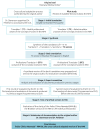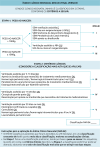Cross-cultural adaptation of the Neonatal Medical Index (NMI) to Brazil
- PMID: 38695419
- PMCID: PMC11059933
- DOI: 10.1590/1984-0462/2024/42/2023164
Cross-cultural adaptation of the Neonatal Medical Index (NMI) to Brazil
Abstract
Objective: To perform a cross-cultural adaptation and assess the content validity of the Neonatal Medical Index (NMI) for the Brazilian context.
Methods: The cross-cultural adaptation was completed in six steps, including translation, synthesis of translations, back translation, submission to an expert committee, testing of the prefinal version, and appraisal by the original author. The expert committee assessed the equivalence between versions based on the percentage of agreement, and content validity was evaluated using the content validity index (CVI) for each item of the scale (I-CVI) and for the overall scale (S-CVI) in terms of representativeness and clarity. Participants of the prefinal version also evaluated the CVI for clarity.
Results: After two evaluation rounds of the expert committee it was attained 98% agreement, attesting to the equivalence between the instrument versions, maximum values for representativeness I-CVI and S-CVI/Ave (1.00), and high values for clarity I-CVI (all items ≥0.97) and S-CVI/Ave (0.98). The expert committee members defined that the Brazilian version of the instrument would be called Índice Clínico Neonatal (NMI-Br). The NMI-Br reached high values of CVI for clarity (all I-CVI ≥0.86 and S-CVI/Ave=0.99) among the participants of the prefinal version.
Conclusions: The NMI-Br is the Brazilian version of the NMI, obtained in a rigorous cross-cultural validation process, counting with adequate values of content validity.
Objetivo:: Realizar a adaptação transcultural e avaliar a validade de conteúdo do Neonatal Medical Index (NMI) para o contexto brasileiro.
Métodos:: A adaptação transcultural foi realizada em seis etapas, incluindo tradução, síntese das traduções, retrotradução, submissão a um comitê de especialistas, teste da versão pré-final e avaliação do autor original. O comitê de especialistas avaliou a equivalência entre as versões com base na porcentagem de concordância, e a validade de conteúdo foi avaliada por meio do índice de validade de conteúdo (IVC) para cada item da escala (I-IVC) e para a escala geral (S-IVC) em termos de representatividade e clareza. Os participantes da versão pré-final também avaliaram o IVC quanto à clareza.
Resultados:: Após duas rodadas de avaliação do comitê de especialistas obteve-se 98% de concordância, atestando a equivalência entre as versões do instrumento, valores máximos para representatividade I-IVC e S-IVC/Ave (1,00) e altos valores para clareza I-IVC (todos os itens ≥0,97) e S-IVC/Ave (0,98). Os membros do comitê de especialistas definiram que a versão brasileira do instrumento se chamaria Índice Clínico Neonatal (NMI-Br). O NMI-Br alcançou altos valores de IVC para clareza (todos I-IVC ≥0,86 e S-IVC/Ave=0,99) entre os participantes da versão pré-final.
Conclusões:: O NMI-Br é a versão brasileira do NMI, obtido em rigoroso processo de validação transcultural, contando com valores adequados de validade de conteúdo.
Conflict of interest statement
Figures
References
-
- World Health Organization . International statistical classification of diseases and related health problems. 5th ed. Geneve: World Health Organization; 2016.
-
- Korner AF, Stevenson DK, Kraemer HC, Spiker D, Scott DT, Constantinou J, et al. Prediction of the development of low-birth-weight preterm infants by a new neonatal medical index. J Dev Behav Pediatr. 1993;14:106–11. - PubMed
Publication types
MeSH terms
LinkOut - more resources
Full Text Sources



